Scottish Bluebell
Its time I tried the Scottish Bluebell in the garden, Bluebell (Campanula rotundifolia) (Harebell)
Campanula Rotundifolia! (Harebell)! Naw its the Scottish Bluebell. Well I suppose officially its a Campanula and its also known as the Harebell by our neighbours across the border.
But, hey, this is Scotland and we claimed it hundreds of years ago, and guess what, we called it the Bluebell, not any old Bluebell, but our Bluebell. We Scots have a history of claiming stuff as belonging to us
The Scottish Bluebell is a very pretty sight growing wild throughout Scotland preferring dry conditions and sandy soil near the coast. It is indeed native to this land.
We have established that the above plant, beautiful as it is, is not a Bluebell. I suppose the main give away is, unlike the true Bluebell our one is not Spring flowering. The Scottish namesake flowers between the months of July and September. Reaches a height of about 20cm and the nodding flowers are held singly on thin wiry stems.
The pictures I show of them were taken on a visit to the beautiful Balmedie Beach which is a few miles north of Aberdeen.
The Bluebells were growing prolifically in a wild flower meadow beside the path leading to the beach.
It would only be fair to make mention of the true Bluebell which is native to the UK, well it is in fact to be found growing wild south of the border. (Hyacinthoides non-scripta) Flowering April/May, the Bluebell woods are quite stunning. Unfortunately the English Bluebell is under threat from the more robust Spanish variety which lacks the charm of the English Bluebell.
The picture below is another of our Scottish one, simply because I don’t have a picture of the English bluebell.
________________________
Well, look what decided to make an appearance in the garden yesterday. Its not the English Bluebell, its the much less popular Spanish one, Hyacinthoides hispanica. It photographs well, however it is a bit of a thug, with masses of broad leaves and very difficult to get rid of as the bulbs, even if you plant them shallow, will burrow into the earth so deeply you will have difficulty removing them.
______________________
I thought last Spring the weather was unusually good however this year it is sensational.
Here is a look at a little more of what has been going on in the garden.
I did show these Tulips as they were beginning to open in late February. Here they are at their best on March 14th.
____________________
The Heather Erica carnea foxhollow is flowering nicely. The foliage of this one turns almost lime green once the blooms have gone over, and the flowers turned a more definite pink a week or so after taking this picture. The Hellebore yellow lady has a fair amount of blooms considering this is its first Spring in the garden.
_____________________
I cant ever recall planting the Chionodixa. They are popping up through the Heather bed, not causing any harm though and the leaves will soon die back.
__________________________
Here is this Pieris yet again. I talked of it last year as being the best Pieris in the garden and how I did not know which variety it is. Have you ever seen so many blooms on one of these shrubs.
_____________________________
This is another Dwarf Tulip which is growing away nicely in a spot just a couple of yards from the kitchen window, oh that’s a few centimetres short of two metres.
_________________________
The Anemone Blanda is opening up nicely in the woodland area. Here it is looking very special in a planter in the front garden.
________________________
At last, a song thrush back in the garden. Its fully two years since we last saw one. Not so very long ago they were regular visitors. I think its unimpressed with that plastic duck.
If you happen to leave a comment I will be sure to visit your site and do the same


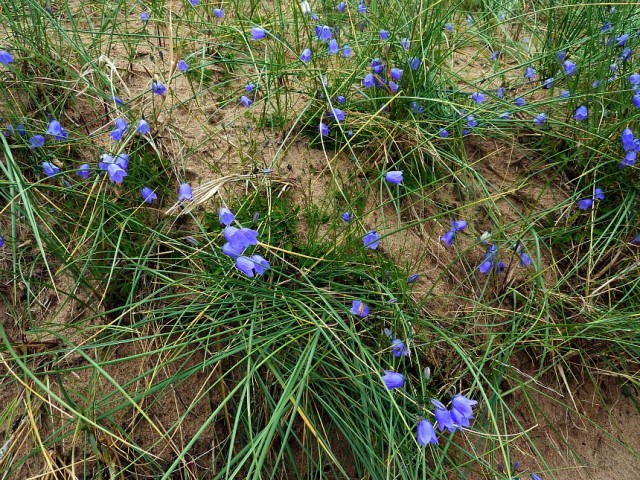

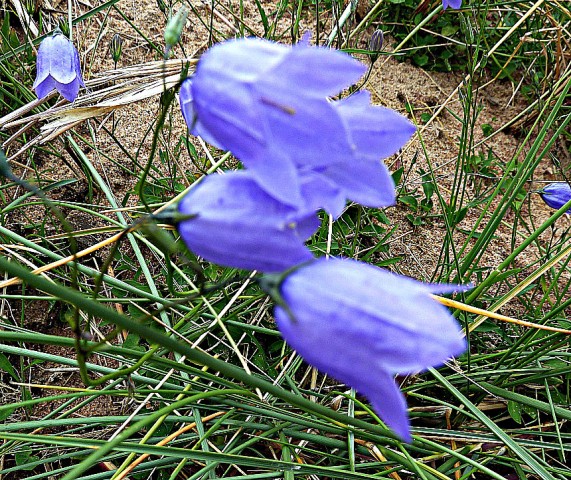
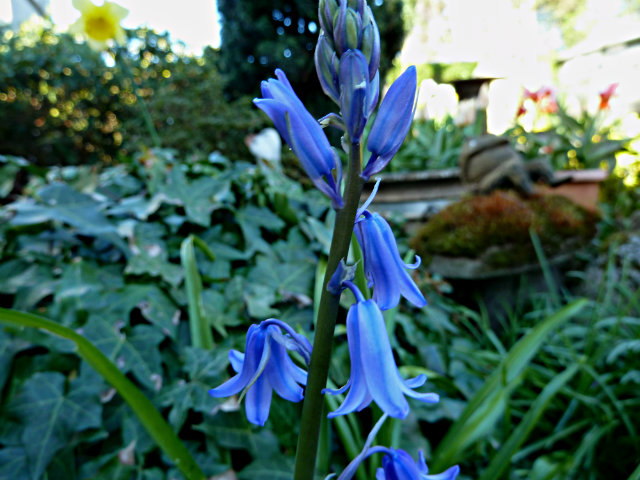

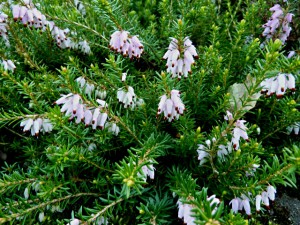
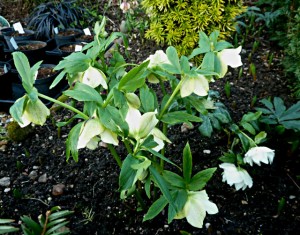

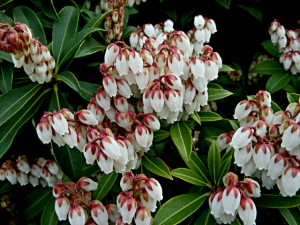


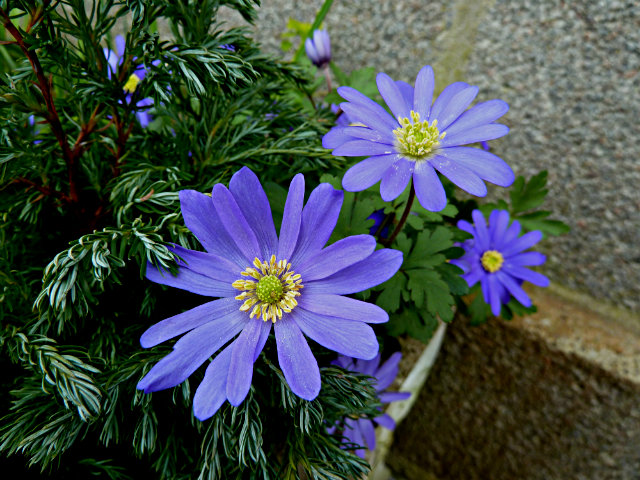
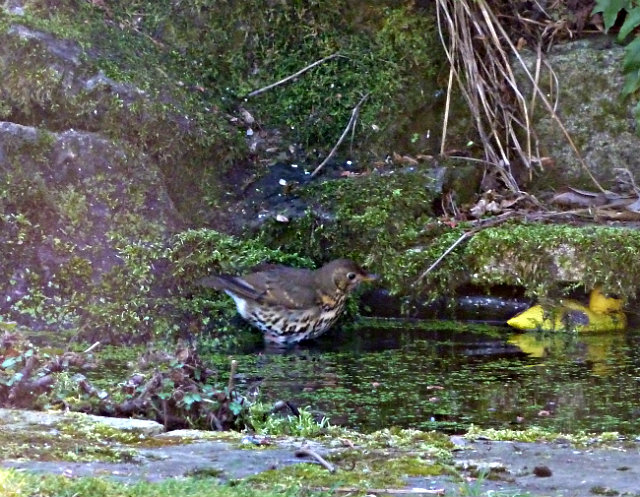
K, Glad you connected with my views on the bluebell.
Hello Alistair,
Sorry to be late in commenting, but I thought you were still hibernating! I’m pleased to find you standing up for the bluebell. It makes me furious to find wild hyacinths called ‘Bluebells’ here in Scotland – even by some people who should know better…..
The individual flowers of the Hyacinthoides look pretty good Jordan but the general habit is not so attractive.
That is a very lovely photo of the beach. Campanula rotundifolia is also native to western Washington & grows on up the coast of British Columbia to Alaska. We call it Common Harebell. We have Hyacinthoides too, which we call Bluebells. But that is not native here. It is an invasive alien that causes me a lot of bother in the garden. It seems impossible to eradicate.
Your probably right about the thrush catmint, I am rubbish at picking up on these things. To be quite honest I never did call it a harebell.
Hi Alastair, I don’t know why you say that about the thrush. I think it fancies the plastic duck. I think it’s stalking it. In fact think I detect a distinct gleam in its eye … Now to the important issue of the harebell / blue bell / campanula. I think if you Scots want to call it your blue bell you ought to be able to do it. Remember what Shakespeare said in Romeo and Juliet? ‘What’s in a name? that which we call a rose By any other name would smell as sweet’. cheers, cm
Love the Scottish Bluebells, and that beach looks divine! You have some lovely things going on in your garden too. Lovely crisp close-ups!
The rest of them don’t know what they are missing Erin.
Well Alistair, I can see that bluebells are a great topic of conversation. I never knew so many people were fans, or not, of he bluebell. I have some here off the west coast of Canada, and need to be wary of them seeding everywhere. I try to nip them after flowering, but the odd rogue clump has ended up elsewhere.
I have never been to Scotland but my grandfather was born in Linlithgow and was an Auchterlonie. He and I were the only ones who would eat haggis.
I am honoured Beth, it is so very kind of you.
Only the very hardy Bom.
I just visited you blog lately, and plan to return in the future. Your blog is a joy to visit. So much so that I’ve nominated your blog for The Versatile Blogger award because your blog is inspiring, entertaining and a true joy to visit.
http://www.daylilysoup.com/2012/04/versatile-blogger-award-nomination.html
Off-topic. Do people really swim in your beaches? I wonder about the temperature of the water.
Thanks for the info about the bluebells. See, I didn’t even specify Scottish and just for you, I will specify English and Spanish bluebells.
Alistair pretty cool stuff mate! The bluebells are so beautiful. Though I liked the Chionodixa most. Great post! Very informative. Thank you so much!
Thank you wise one, is it frankincense or myrrh.
I come bearing gifts…
http://www.tidygardensbyjane.co.uk/2012/04/sunshine-award.html
SB, I am very careless regarding the names of these bulbs which I buy for pots.
It would have been warm enough last week Jennifer, surprisingly. However that picture was taken last August.
Now Linnie, yer havin a laugh, but I’m glad you like them.
I ordered Scottish bluebell seed from Chiltern a few years ago. The plants are a wonderful addition to the beds, growing up and among their neighbors and blooming with those adorable blue flowers. Sometimes, if the breeze is right, the bells make a little ringing sound. Just sometimes. But they are always cheerfully pretty and I love them.
Hi Alistair, I missed your last post with the Ribes Sanguinium White Icicle. Wow! How gorgeous!! The bluebells and the beach with the blue skies are just as lovely. Would it be warm on the beach at this time of year or does the image just look warm? I wish I could grow Pieris here!
Thanks for the info on your native bluebells…very interesting. And I love the colors of your blooms at this time of year, especially the red tulips. Do you recall what variety of tulips they are?
Hmm, you may be right Debs, I will keep a lookout for spotted yellow birds with webbed feet
I don’t know, the song thrush looks to me to be eyeing that plastic duck as a potential mate! Your scottish bluebells are a beautiful wildflower. The view of masses of them along the coast must be wonderful. I love your tulips, especially the one near your kitchen window.
Aw, not the plastic duck Jane.
Hi Alberto, I did enjoy your Malteaser.
Those Scottish Bluebells does look pretty growing in drifts along the coast, really lovely! And great collection of blooms as always!
Hi Alistair! A few years ago I went to visit a friend in Malta. He explained me eveything about the island, the people, the buildings and everything (yes EVERYTHING) was preceded by ‘maltese’. So you might put some maltese lemon and some maltese sugar to drink a damn maltese tea. You Scots are not that different, are you? 🙂
Those bluebells area real show in the beach anyway, no wonder somebody wants to claim them as its own!
Stunning photos again…but the duck one’s my fav’! x
Probably have your work cut out Rosie.
Thanks for the link to Scotia seeds Chris.
I always think the shorter Tulips look best in containers Christine.
Wow Alistair! What a sight. Those tulips in the blue container are simply perfect in every way. I’m very tempted to plant tulips again this year. Very!
Harebell, Scottish Bluebell – a rose by any ther name. I grew them from seed last year, they flowered profusely and they have happily survived the winter. They are quite common here on South Uist.
As I live in an environmentally sensitive area, if I grow native wildflowers I always ensure that I obtain Scottish seed when possible, usually from Scotia Seeds.
Those little wild scottish bluebells look so pretty growing in that costal path. I have just a few spanish bluebells though now that I’m more aware of the problems with them naturalising with our native bluebell I too am going to try and get rid of them once and for all.
Wellywoman, perhaps they were rather late in coming into flower at Balmedie.
I am easily persuaded Carolyn, however even without the native variety I would still battle on to rid my garden of the Spanish bluebell.
Spanish bluebells, which I call Scilla campanulata, are gorgeous here. They do spread quite rapidly but if you plan for that when and where you plant them, they are gorgeous. Of course, there is no native bluebell to be crowded out. I would feel differently if there were.
We were lucky enough to see some Scottish Harebells on our holiday on Skye and Mull last year. We were there in June so I think the warm spring must have encouraged them to flower earlier. They are very pretty, such a lovely colour.
Frances, I have never actually seen an English woodland smothered in Bluebells, I can imagine it would be quite a sight. Donald Trump is fairly making his presence felt.
interesting Bluebell discussion Alistair, I have always liked Harebells and was pleased to find when I moved to Scotland that they are know as the Scottish Bluebell and grow wild on the islands, I also like the English Bluebell and have many fond memories of seeing woodland floors a carpet of blue in springtime,
I have the English/Spanish blue and white bells in my garden simply because they were in my parents garden that my Dad had planted many years ago, I had thought they were the English Bluebell but after finding a page about them on the RHS website and closely looking at mine I realised I have both and apparently the Spanish and English interbreed!
Mr Trump wants to trample over Scotland or so it sounds everytime I hear about him on the radio,
you have lots flowering (as usual) and it all looks beautiful, no you and Myra could never move from a garden like that, Frances
The beach is beautiful Donna. This is the area where Donald Trump has just about completed stage one of his massive golf complex. The beach fortunately covers quite a number of miles.
b-a-g, I have tried for years to get rid of it, I will now just try to keep it from spreading.
Spurge,blue flowers do seem to strike a chord with everyone.
The weather here has just turned a lot colder Holley, hope it changes soon.
Yes Helene, I also prefer it, and I am happy to share with our Nordic friends.
Hi Alistair, I was going to come back and comment about the bluebell, but Flaneur beat me to it…in Norway, where I come from, Campanula rotundifolia is also known as bluebells, and grow wild everywhere. We don’t have neither English nor Spanish bluebells, except for perhaps in some garden centres. When I moved to London 13 years ago I was threrefore surprised and a bit confused about what was called bluebell here. I like the Norwegian/Danish/Scottish one much more 🙂
I can see why the Scottish claimed that flower. Lovely. And the weather here has been sensational, too. I hope it stays that way all summer! Lovely blooms. I agree your Pieris is wonderful. And I love that anemone.
Oh my – your pieris is breathtakingly beautiful. It looks so happy there – you must be taking very good care of it. Not hardy in my area, but I have admired even some very sickly looking ones on the east coast of America. I’ve been planning to try bluebells and did not know the spanish kind were thuggish. Not sure if the english or scottish kind will take here, but I of course have to give it a try since they’re blue.
Wow the pieris is amazing! I was taking photos of mine today because it has started growing pink leaves, but it only has three sprays of flowers.
The non-scottish bluebell looks quite at home in your garden. Are going to let it stay?
Your campanula is also our native..I planted a few and we shall see if they will grow and multiply…so pretty..that beach scene is gorgeous Alistair…you live is a lovely place. I try to grow English bluebells but the Spanish do better in my garden and don’t seem to be a thug for my climate. I adore your blooms..mine are just getting going with the cold weather. The plastic duck is adorable 🙂
Lona, this coastline is where Donald Trump is creating his billion pound golf course.
Hi Alistair. What a lovely coastline. I love looking out over the sand and water in your photo. Your Pieris is blooming so good. It is just loaded. One of your flowers I just love and that is that blue Anemone. Just gorgeous. Have a wonderful weekend.
Crystal, aw, go on just admit it and we will say no more.
Erm, excuse me, that’s a harebell. No way is it a Scottish Bluebell. I mean, apart from it being blue, having bell-shaped flowers, and growing in Scotland. Oh, go on then, I’ll let you have that one.
I really do agree with you about the Spanish Bluebells though. I planted some years ago, before I found out what thugs they were.
Larry, the early Spring has been very comfortable over here with temperatures between 63f and 72f all change today as it drops to 48 brr.
Soren, thanks for the visit and interesting comments. Although we don’t accept garden visit requests I am very flattered by your interest in our garden, and I will of course reply to your email.
Oh, so many things to comment on!!!
First of all, here in Denmark the Scottish bluebell is known simply as “blåklokke” (i.e. “bluebell”), whereas both the English and Spanish bluebells are known only under their latin names or as “fake hyacinths”… (Also, what you call the “Scottish” bluebell can be seen flowering in Greenland in summer as well! It’s a genuine trooper, that flower…)
Secondly, the anemone blanda is one of my favourite flowers. On some Danish islands it’s a wildflower, though not around my garden in Northern Sealand. Instead we have the white Anemone Nemorosa blooming across vast areas of woodland floor in a few weeks’ time, sometimes interspersed with the yellow anemone ranunculoides. All three have been planted in The Hedgerow, since this is the area that best reproduce their native woodland habitat.
I love the variegated leaves on your tulips; even when the flowers are gone those leaves will be interesting by themselves until they start to die down.
And finally: Would it be possible to visit your garden? I’m in Aberdeen next weekend Thursday through Sunday, and since my husband will soon be moving back to Denmark, this will probably be my last visit to Aberdeen for a long time. I’d love to see what your garden looks like in real life.
Hi there Alistair… I found the comment on the Spanish bluebells to be quite interesting… they don’t do all that well here and I do enjoy them although I do wish they would stand up a bit better. Looks like we are going to have an amazing spring all told and so far have avoided any frost, despite being seven weeks early… things are bit more normal now which may mean lengthier bloom periods than normal which would be wonderful. Take care, Larry